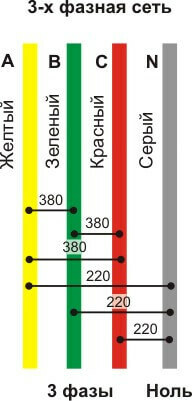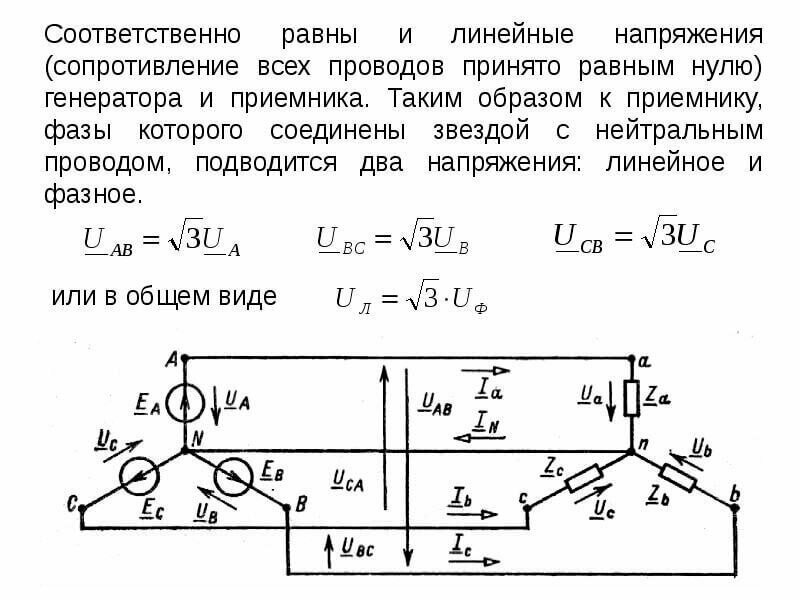Most often, the consumer does not think about which AC mains his apartment or private house is powered from. This can be a single-phase or three-phase connection. The main consumers of electrical energy are devices designed for a voltage of 220 V. Now they began to produce and install household electrical equipment for 380 V. These are mainly electric stoves in high-rise buildings. And in private households, when arranging a workshop, where machines are used with a connection to a three-wire electric line. In this article, we will understand the differences between single-phase and three-phase voltage.
Content:
- What network are our houses and apartments powered from?
- The main differences
- Why powerful equipment is often three-phase
- Advantages and disadvantages
- Do single-phase networks meet in their purest form?
What network are our houses and apartments powered from?
Most apartments and private houses use a single-phase electrical connection. Moreover, the general load consumer does not exceed 10 kW. The share of such connections accounts for about 90% of all electrical consumers.
The remaining 10% use a three-phase connection. It is used if it is necessary to connect a load. power more than 10 kW. For this, use AC mains at 380 volts.
These include residents of cottages or private houses and owners of apartments where electric stoves or other appliances are installed that are designed to connect to 380 V.
The main differences
A common factor is the number of wires and voltage. This is where the differences end. A single-phase connection is characterized by connecting two / three wires to a house or apartment (phase, zero, ground). Usually the cross section of the conductors is 4-6 mm2. And in the house they use wiring 1.5-2.5 mm2.
Moreover, it is limited by the maximum power consumption, which should not exceed ten kW. Difficulties may arise with the connection of consumers designed for three-phase voltage. When connecting, additional devices will be required, and you also need to be prepared for a loss of power.
Usually, three phases are supplied to an apartment building, and only one phase comes to each apartment. At the same time, they try to distribute the load proportionally, excluding phase imbalance. It is also taken into account that the voltage of 220V is less dangerous than 380V, from the point of view of safety.
If the consumer plans to connect to electrical network with a dedicated power of more than ten kW - three-phase voltage must be used.
The difference in this case lies in the supply of a cable with four / five cores to the house or cottage. In what consists difference from a two-wire connection. In this case, the consumer receives two voltage values: the linear voltage will be equal to 380 V, and the phase voltage - 220 V.
Measurement is made as follows. The phase voltage is measured between the neutral conductor and each phase alternately, the linear voltage is measured between the phases.
The figure below shows how to measure phase and line voltage.

It should be borne in mind that in cottages where the installed power exceeds ten kilowatts, but there is no three-phase load, the active power must be evenly distributed between the phases.
This is difference with single-phase connection, there is no need to distribute power.
The figure below shows the connection diagram of a single-phase load evenly distributed over three phases and formula dependence of line voltage on phase.

In this case, it is not required to use switching equipment (automatic machines, starters) for high currents. More often three-phase network used for industrial enterprises, shops, office premises.
Why powerful equipment is often three-phase
The main factor to use a three-phase connection to a powerful load is the transmission of high power with a smaller cable cross-section, relative to a single-phase one. This significantly reduces the cost of electrical networks and switching devices.

Such a supply of electricity is used for industrial enterprises, workshops, farms. That is, for organizations where the main consumers are three-phase electrical installations.
These can be electric motors, powerful drying units, stationary welding equipment, metalworking and woodworking machines, etc.
Advantages and disadvantages
Each of the networks single-phase and three-phase current system has its advantages, but not without its disadvantages.
Let's consider the main advantages for the 220V line:
- They are uncomplicated. The scheme can be understood by a person with minimal knowledge of electrical engineering.
- Two wires are sufficient for connection (if grounding is not used). This greatly simplifies the network.
- Relatively low hazardous voltage.
The main disadvantage is high currents with high power consumption, therefore, single-phase connection is practically not used for powerful devices (7-10 kilowatts or more). Now consider, hit differs 3-phase network from 1-phase.
For networks with a voltage of 380 V:
- The connected power is limited only by the cross-section of the conductors and the power allocated by the mains.
- Can be used to provide electricity to any facility.
- It is possible to "select" the phase with the best parameters, to supply important single-phase consumers, for this, phase switches are used.
The disadvantages include:
- Expensive cables and switching equipment.
- Dangerous voltage.
Do single-phase networks meet in their purest form?
The energy system of our country is designed to use a three-phase network. All generators in power plants produce three phases. This applies to hydroelectric power plants, nuclear power plants, thermal, tidal, etc.
Such a scheme of power transmission over long distances is the most economical. To transmit the same power with a single-phase line, wires of a large cross-section will be required. Therefore, single-phase networks for the transmission of electricity are not used.
The figure below shows a diagram of the transmission of electricity from a CHP plant to a consumer.

However, single-phase power grids are widely used as emergency power supplies. For this, gasoline or diesel power plants are used. Installed at facilities where power outages are unacceptable. For example, to supply electricity to hospitals (these are intensive care units or operating rooms), telephone stations, operational warning systems, etc. For powerful consumers, three-phase diesel engines are used generators.

